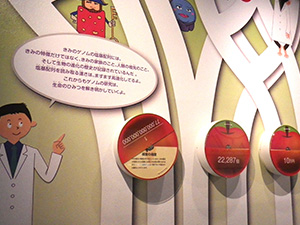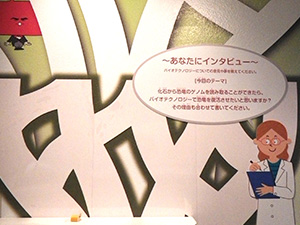Nagoya City Science Museum
TOP > Exhibition Guide > Floor Map> Forest of Biotechnology
Forest of Biotechnology



Purpose of Exhibition
These exhibit items are the ending for the "Secrets of Life" permanent exhibition room on the 5th floor of the Life Science Building and comprise 4 corners.
The first, "The Fruits of the Genome", introduces topics concerning Genome science (Genome: the entire base sequence in the genes of a certain organism). Please note that genome science is developing rapidly and spreading in various fields. Also, the various characters of this floor are hidden in the biotechnology trees on the wall, so try to find them.
The neighboring corner, "Tell me your opinion" is the corner where we have all of you to announce your opinions concerning biotechnology. You can also read a variety of opinions from other people and further deepen your own understanding.
The final corner, "Bio Topic" and "Bio Gallery", primarily introduces the research topics and results of biotechnology research organizations in this region. There are plans to change the exhibition contents in a timely manner. Let's keep watch on how these humble buds of biotechnology grow.
Additional Knowledge
On April 14, 2003, the completion of sequencing the human genome was announced. Reading the 3.3 billion base pairs in human DNA involved scientists around the world and it is said to have taken 13 years and 350 billion yen. From around 2005, the "next-generation sequencer", which reads base sequences efficiently, and computers to process the resulting enormous volume of information were developed one after the other. We have now reached the point where the genome of one person can be sequenced in just a few weeks and for a mere ¥100,000 or so. This is truly the arrival of the personal genome age.
What will you find out if you read the information in your own genome? You will understand the "design drawings" that produce your characteristics, illnesses of course, your height and body type, your character, your capacity for exercise, etc. The genome is the ultimate collection of personal information.
That is not all. Your genome is not just yours. The genome also shows family relationships and relationships among races, for example "the roots of the Japanese". Also, since it has become possible to extract DNA from fossils too, it is also possible to research our relationship with Neanderthals, which were a species in the genus Homo and went extinct 20 thousand years ago.
To go further, the genetic system using this DNA is common to all organisms on the Earth, so by comparing their genomes, we can learn about the path of evolution of organisms and where species of organisms branched off.
Your genome is not only yours but also your family's and humanity's. And your genome belongs to all living beings on the Earth. The following words appear at the end of the "Wonder Genome", which plays at the entrance to the exhibit room on the 5th floor of the Life Science Building. You should know the meaning already.
"The world of living beings: the same with variety, variety with the same."
Article by Chieko Ozaka, curator
